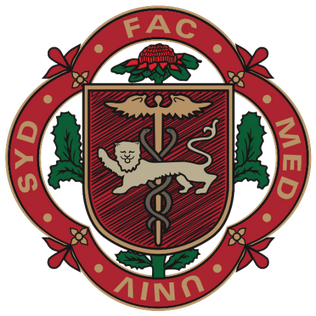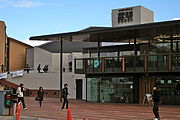The University of Texas Health Science Center at Houston is a public academic health science center in Houston, Texas, United States. It was created in 1972 by The University of Texas System Board of Regents. It is located in the Texas Medical Center, the largest medical center in the world. It is composed of six schools: McGovern Medical School, The University of Texas MD Anderson Cancer Center UTHealth Graduate School of Biomedical Sciences, UTHealth School of Dentistry, Cizik School of Nursing, UTHealth School of Biomedical Informatics and UTHealth School of Public Health.
UConn Health is a healthcare system and hospital, and branch of the University of Connecticut that oversees clinical care, advanced biomedical research, and academic education in medicine. The system is funded directly by the State of Connecticut and the University’s financial endowment. Its primary location, UConn John Dempsey Hospital, is a teaching hospital located in Farmington, Connecticut, in the US. In total, UConn Health comprises the hospital, the UConn School of Medicine, School of Dental Medicine, and Graduate School. Additional community satellite locations are located in Avon, Canton, East Hartford, Putnam, Simsbury, Southington, Storrs, Torrington, West Hartford, and Willimantic, including two urgent cares in both Storrs and Canton. UConn Health also owns and operates many smaller clinics around the state that contain UConn Medical Group, UConn Health Partners, University Dentists and research facilities. Andrew Agwunobi stepped down as the CEO of UConn Health in February 2022 after serving since 2014 for a private-sector job. Bruce Liang was UConn Heath's interim CEO for 2022-2024 and remains dean of the UConn School of Medicine. Andrew Agwunobi returned to UConn Health as Executive Vice President of Health Affairs and CEO beginning May 31, 2024.

The Cardiff University School of Medicine is the medical school of Cardiff University and is located in Cardiff, Wales, UK. Founded in 1893 as part of the University College of South Wales and Monmouthshire, it is the oldest of the three medical schools in Wales.

Hull York Medical School (HYMS) is a medical school in England which took its first intake of students in 2003. It was opened as a part of the British government's attempts to train more doctors, along with Brighton and Sussex Medical School, Peninsula Medical School and University of East Anglia Medical School. It is the joint medical school of the Universities Hull and York. The University of Hull was rated Gold in the Teaching Excellence Framework 2023 as was the University of York. The latter is also a member of the Russell Group; an association of 24 world class, research intensive universities.

The University of Birmingham Medical School is one of Britain's largest and oldest medical schools with over 400 medical, 70 pharmacy, 140 biomedical science and 130 nursing students graduating each year. It is based at the University of Birmingham in Edgbaston, Birmingham, United Kingdom. Since 2008, the medical school is a constituent of The College of Medical and Dental Sciences.

Keele University School of Medicine is a medical school located in Newcastle-under-Lyme and Shrewsbury. The first two years of the school's MBChB degree are mostly taught on the Keele University campus, while early contact with patients is critical, and there is significant interaction in a clinical environment from the second year onwards.
The University of St Andrews School of Medicine is the school of medicine at the University of St Andrews in St Andrews, Fife, Scotland and the oldest medical school in Scotland.
The Duke University School of Medicine, commonly known as Duke Med, is the medical school of Duke University. It was established in 1925 by James B. Duke.

The University of Glasgow School of Medicine, Dentistry & Nursing is the medical school of the University of Glasgow, Scotland, and is one of the largest in Europe, offering a 5-year MBChB degree course. It is ranked 2nd in the UK for medicine by The Times Good University Guide 2018 and joint 1st in the UK by the Complete University Guide 2021. The School of Medicine uses lecture-based learning, problem-based learning and Glasgow's case-based learning.
Aberdeen University School of Medicine, Medical Sciences & Nutrition contains the Medical School and Dental School at the University of Aberdeen in Scotland. It also provides training and carries out research in medical sciences, nutrition, public health, dentistry, health sciences, physician associate studies at BSc, MSc, and PhD levels. The current school was formed from the merger of the former School of Medicine & Dentistry, School of Medical Sciences, and the Rowett Institute of Nutrition.

The School of Clinical Medicine is the medical school of the University of Cambridge in England. The medical school is considered as being one of the most prestigious in the world, ranking as 1st in The Complete University Guide, followed by Oxford University Medical School, Harvard Medical School, and Stanford School of Medicine and 2nd in the world in the 2023 Times Higher Education Ranking. The Cambridge Graduate Course in Medicine (A101) is the most competitive course offered by the University and in the UK, and is among the most competitive medical programs for entry in the world. The school is located alongside Addenbrooke's Hospital and other institutions in multiple buildings across the Cambridge Biomedical Campus.

The University of Sydney School of Medicine, also known as Sydney Medical School (SMS) is the graduate medical school of the University of Sydney. Established in 1856, it is the first medical school in Australia. In 2018, Sydney Medical School joined the newly formed Faculty of Medicine and Health at the University of Sydney. SMS is ranked 19th in the world and second in Australia in the 2021 QS Subject Rankings for medicine.
The Monash University Faculty of Medicine, Nursing and Health Sciences is an Australian healthcare provider. It comprises 10 schools, teaching and clinical centers and research institutes. The faculty offers undergraduate, postgraduate and professional education programs in medicine, nursing and allied health, and is a member of the M8 Alliance of Academic Health Centers, Universities and National Academies.
The University of Edinburgh Medical School is the medical school of the University of Edinburgh in Scotland and the United Kingdom and part of the College of Medicine and Veterinary Medicine. It was established in 1726, during the Scottish Enlightenment, making it the oldest medical school in the United Kingdom and the oldest medical school in the English-speaking world.

Swansea University Medical School is a medical school on Swansea University's Singleton campus. It is linked to additional teaching centres located throughout South and West Wales, including Cefn Coed Hospital, Singleton Hospital and Morriston Hospital in Swansea, Prince Philip Hospital in Llanelli, Withybush General Hospital in Haverfordwest and Bronglais Hospital in Aberystwyth. The Medical School also has a network of primary care teaching centers.

The University of Sheffield Medical School is a medical school based at the University of Sheffield in Sheffield, South Yorkshire, England. The school traces its history back to at least 1828. It operated independently until its merger with Firth College and Sheffield Technical School in 1897, and is now an integral part of Sheffield's Faculty of Medicine, Dentistry and Health.

The University of Liverpool School of Medicine is a medical school located in Liverpool, United Kingdom and a part of the University of Liverpool. It is one of the largest medical schools in the UK, and in 1903 became one of the first to be incorporated into a university.

The Faculty of Medicine, The Chinese University of Hong Kong, branded as CU Medicine, is the medical school of the Chinese University of Hong Kong, a public research university. Established in 1981 as Hong Kong's second medical school, the faculty consists of five schools offering undergraduate and postgraduate programmes, including in the fields of medicine, nursing, pharmacy, and traditional Chinese medicine. The Prince of Wales Hospital is the faculty's teaching facility and base of research. CUHK is a bilingual university; in general, courses are taught in English and/or Chinese.
Aston Medical School (AMS) is part of Aston University, located in the city centre of Birmingham, in the United Kingdom. It is the 34th medical school in the UK and 6th in the Midlands. It exists to train doctors and to promote medical research. Aston Medical School was conceived and led by the founder Professor Asif Ahmed, who was the inaugural Executive Dean and also served as the first Pro-Vice-Chancellor for Health. The current Dean of Aston Medical School is Professor Anthony Hilton.
The University of Ghana Medical School also UGMS is the medical school of Ghana's first public research institution, the University of Ghana. It is currently located at the Korle Bu Teaching Hospital in Accra. The medical school was first planned in 1919, but took its first students in 1962.












